An Old Idea becomes New again…
It was late March when the lockdown in Mauritius was announced. For billions, globally, the Covid-19 pandemic has spelt a period of deep uncertainty and stagnation, being self-sufficient and resourceful at a time when essentials are frequently sold out at grocery stores, isn’t a bad thing.
The early weeks of the pandemic threw the global supply chain into chaos, setting off a wave of panic-buying across the world and a widespread fear of food shortage. The US faced a shortage of milk, Australia had almost no flour and in Britain almost no eggs on supermarket shelves, while Italy faced a scarcity of pasta. Many countries reported fears of labour shortages for perishables such as fresh vegetables, according to Time magazine. As with any crisis, people quickly responded by taking matters into their own hands – as highlighted by soaring seed sales across the world.
Across social media, plant lovers, amateurs and first-time gardeners are sharing the works in progress and landscape projects in their backyards.
This global rush to grow-your-own is being compared to ‘victory gardening’. The term ‘victory garden’ was first popularised overseas in the United States and the United Kingdom and started being used in Australia after then-prime minister John Curtin launched a campaign in 1942 called ‘dig for victory’.
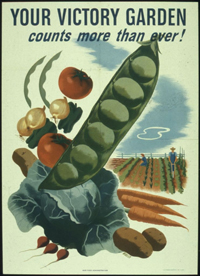
From North America to Great Britain and to Australia, these kitchen gardens became popular in World War One and World War Two when food shortages reached critical levels in the Allied nations. In response, governments called upon citizens to fuel the war effort and feed the country. Working the soil became a patriotic duty.
Historian and writer Richard Aitken, who specialises in the history of gardens, compared the sudden focus on growing our own food to the vegetable patches that served as a type of “backyard patriotism” during World War I and II.
“This current pandemic has given rise to this idea of being self-sufficient and bartering vegetables with neighbours,” he said.
“The big difference between wartime and being in the middle of a pandemic is that the social distancing and self-isolation that we’re having to enforce now wasn’t necessarily in force during war. It was to encourage self-sufficiency and thrift and the whole idea of a collective effort of ‘you grow tomatoes, I’ll grow potatoes or lettuce’, and you could trade amongst neighbours.”
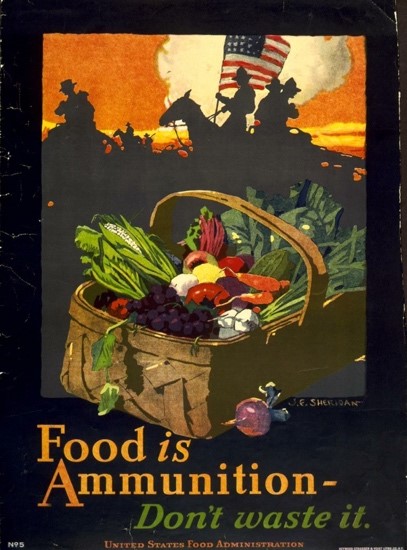
But governments had another reason for promoting victory gardeners: to boost morale. While struggling to help on the home front, people felt empowered by the simple act of planting seeds. Well-fed, healthy citizens were also one more step towards winning the war. Perhaps this is why the gardens’ legacy can still be felt today.
While using the analogy of war to describe a viral pandemic is controversial, it makes sense to connect these two moments in time. It is a revival of same community spirit back then – and a victory garden quite literally says we are in this together.
As the coronavirus sweeps through cities around the world, exposing inequalities, environmental degradation and other societal ills, gardening gives communities an opportunity to increase healing and resilience. Maybe your income has been affected by COVID-19 and you’d like to trim your grocery bill. Maybe you’re just not that keen on an extra trip to the store to pick up fresh produce. Whatever the case, gardening gets you outside, relieves stress and provides an opportunity for exercise. It also helps you feel empowered in a world where much of “normal life” is at a standstill.
Resilience gardens can be anywhere: community gardens, private gardens, medicine gardens and even balcony gardens. They provide well-documented mental health benefits from being outside and give out-of-school kids the chance to learn while interacting with nature.
So how do you start your own?
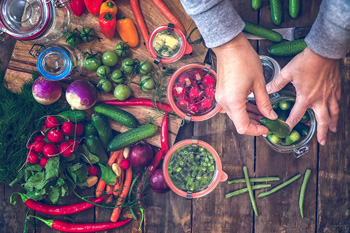
If you’re new to gardening, now is a great time to start. Self-isolating doesn’t stop you from turning over soil and planting seeds—all of which can be done in your own backyard. If you don’t have a backyard, there are scaled-down versions of victory gardening that might fit your space.
During the last century, victory gardens were simple and straightforward by necessity. Many things were in short supply, including some tools and the metal to make them. People focused on planting staple crops that were most likely to succeed with minimal effort. This included standbys like carrots, potatoes, rutabagas, cabbages and beets, along with nutrient-rich crops like peas, Swiss chard, lettuce, and spinach. Today we have more options at our fingertips. We can order most supplies to our door, and we can get advice with a simple click. What we can’t find in online articles, we can ask a social networking group and others will rush to answer our question. We also have many options when it comes to choosing our garden.
Ground level
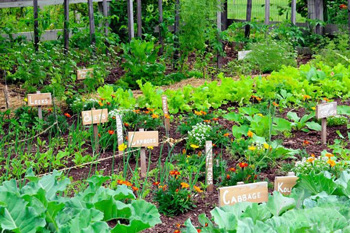
The most common type of victory garden was at ground level. People tilled patches of sod and bare earth, turning over grass or flowerbeds and converting them to productive food gardens. Eleanor Roosevelt even planted a victory garden on the White House lawn after hearing campaign messages from the Department of Agriculture. In-ground gardening is the least expensive and often fastest way to start growing.
Raised beds
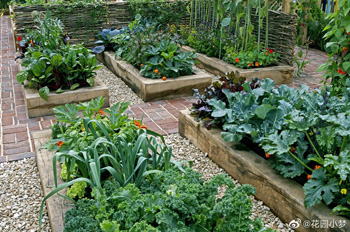
A popular method of choice today, raised beds lift the level of your garden above ground to make the soil more accessible. The bottom of a raised bed remains open to the ground, so plants can reach the soil below. This means you don’t have to go very high if you have fair soil: just gather that soil beneath and inside your raised bed and you can grow a wide variety of crops.
For the elderly, handicapped or anyone struggling with chronic pain, raised beds make gardening easier and more comfortable. They’re important in urban areas, where people might choose to install them over concrete, pavers or rooftops, creating a garden where one wasn’t possible before. In all areas they help warm the soil earlier in the springtime.
NO BACKYARD? NO PROBLEM!!
Containers and raised planters
A collection of containers on a balcony or patio offers urban gardeners the chance to grow their favourite vegetables, even if they don’t have a yard. Plant pots and containers come in many different materials, each with their own benefits and requirements.

Pallet Vertical Planters
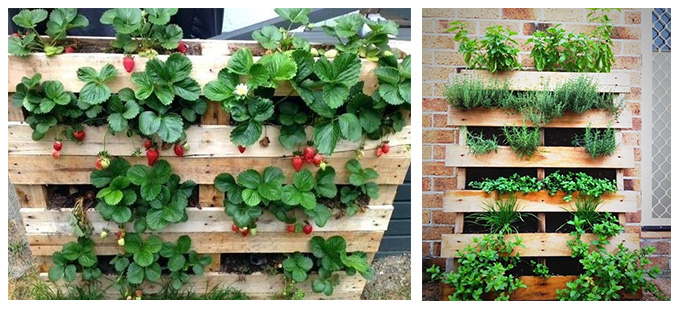
WANT TO GET TECHNICAL?
Try hydroponics!!

Hydroponics is the cultivation of plants in nutrient-rich water. There are many different styles of hydroponic gardening, but most use less than 10% of the water used in traditional agriculture. Hydroponics also provides faster growth rates, with some hydroponic plants growing at twice the rate of soil-based plants. Plants can also be grown vertically, re-using the life-giving nutrient solution with little waste.
While hydroponic growing takes more technology than typical growing in soil, it can be very rewarding and a great way to produce safe food, close to the end consumer without taking up a lot of space.
Other benefits of growing locally include the opportunity to reduce the energy intensity of our food system, cut transportation costs, minimize vulnerabilities to scourges like drought, salmonella outbreaks and other contamination problems in huge agribusiness operations, and avoid pesticides and other chemicals that have an adverse environmental impact when used in conventional agriculture and food-production processes.
” Whatever your choice of garden, get started today and
enjoy the fruits of your labour! “
What supplies do you need to get started?
In addition to your seeds, which are detailed below, it’s helpful to have a few other materials on hand to prevent and treat problems as they come up.
1. Complete organic fertilizer
Plants do best when nutrients are readily available. Organic fertilizer feeds the soil and helps to maintain a healthy balance of minerals and elements that your plants need all season long. It also prevents you from depleting your soil over the longer term. Most seed packets recommend adding complete organic fertilizer to your rows during planting time.
2. Compost
There’s a reason why gardeners call compost ‘black gold.’ It contains all the nutrients plants need to thrive, along with excellent soil conditioners and organic matter. Dig into the soil at planting time and add to the soil surface during the growing season alongside plant rows.
3. Neem oil
Neem oil is a great all-purpose, natural insecticide to have on hand when pests strike. It can help with cabbage moths, aphids, and other insects, and slow powdery mildew when it appears on plant leaves.
4. Floating row cover
This light fabric protects young seedlings if the weather is slow to warm up. It’s also great to have if pests threaten your crops.
Preparing your garden
Choose a location that receives 6-8 hours of sun each day. If you don’t have this much sunlight, consider growing leafy vegetables like lettuce and spinach that need less sun and heat. All vegetable crops will need some sun.
As a general rule of thumb, prepare your soil by digging in compost. In future years it’s best to disturb the soil as little as possible.
What to grow in your victory garden?
As mentioned above, victory gardens were dedicated to fruits and vegetables that were easy to grow and keep. While everyone has their favourites, below is a list of what you can grow, depth needed for each vegetable and approximate days to maturity.
1. Beans

There’s a reason why kindergarten teachers choose beans to demonstrate the life cycle of plants: beans are one of the simplest vegetables to grow while being some of the most prolific. When choosing bean seeds, remember the basics: bush beans grow low to the ground and need to be spaced 6 inches apart in rows that are 2 feet apart. Pole beans will climb a trellis and form plants that reach upwards of 8 feet. You can plant them more closely together at 3 inches apart.
When to plant: Soil temperature over 24 C.
Soil depth required: 18-24”
Days to maturity: 50-80 days
2. Beets

Full of antioxidants, beets make a great addition to salads and juices. Their large seeds make them easy to handle for children, and they’re relatively trouble free to grow if planted once the soil has warmed slightly. You can also harvest them at any stage: leaf, shoot and root.
The thing to remember about beets is that thinning is usually necessary. Crowded plants will make for smaller roots, but regular thinning will give you slender pickings for early salads. Beets grow best in well-drained, loose sandy loam. Before planting, gently loosen the soil with a digging fork. It helps to add potash to the bottom of your planting row along with your compost and organic fertilizer: you can do this with a fine sprinkle of wood ash.
Plant seeds 1-2 inches apart and thin any seedlings that emerge to 4 inches. Sow every three weeks for a continuous harvest.
When to plant: Plant when soil temperature is around 25 C.
Soil depth required: 18-24”
Days to maturity: 50-70 days
3. Lettuce
Lettuce grows best in cool weather. Once the temperatures hit 70 F, germination will slow. As the temperature warms further, mature plants will go to seed and stop producing. Before you plant, decide if you want to harvest your lettuce by the head, by the leaves, or both. Head lettuce such as butter and romaine need to be left intact as they mature. You can pick loose leaf varieties as soon as the leaves reach three to four inches long.

After adding compost and organic fertilizer, sow your seeds as thinly as possible. Head lettuce will need about a foot of growing space, while loose leaf varieties can be much closer—about 4-8 inches apart depending on big you want them to get.
When to plant: Early spring to early summer when the soil temperature is around 20 C.
Soil depth required: 12-18”
Days to maturity: 30-70 days
4. Potatoes
There’s nothing quite like digging up a potato plant to find a collection of 10 or even 20 fingerlings waiting in the dark earth. Potatoes need ample space, but this space doesn’t have to be conventional. People have grown potatoes in old garbage cans or bathtubs, in circles of wire mesh filled with soil and leaves, and even in stacks of rubber tires.

Potatoes are extra easy to grow because they don’t require a soil high in nutrients to thrive. Too much nitrogen and they’ll turn out leafy. But potatoes will reward a gardener many times over if tended carefully. A one-pound bag of seed can yield about 10 lb. of potatoes.
Plant 3-4 inches deep in well-drained soil. Avoid watering until plants emerge if possible. This will help avoid disease. When potato plants reach a foot tall, pull the surrounding soil into hills around the base of the plants, covering some of the green leaves. This will help produce more tubers. Finished plants should be 12 inches apart.
When to plant: Plant after the soil warms beyond 20 C.
Soil depth required: 12-18” plus hilling if desired
Days to maturity: 50-100 days. Dig new potatoes 7-8 weeks after planting.
5. Squash

Squash take up a lot of space, but they are prolific under the right conditions. Those conditions usually involve lots of compost or manure: squash are heavy feeders and love an old compost pile to climb on.
If you don’t have a lot of space to grow squash, choose one or two plants from one of the compact (or bush) varieties. Instead of sprawling over a long distance, they’ll grow in a contained area.
Sow seeds 1 inch deep in wide rows and thin to a spacing of 2 feet for summer squash and 4 feet for winter squash. Rows should be 3-4 feet apart.
When to plant: The best soil temperature is around 25 C.
Soil depth required: 24-36”
Days to maturity: 70-120 days for winter squash, 40-75 days for summer squash.
6. Tomatoes

The first thing you need to know about tomatoes is whether you’ll be growing determinate (bush type) or indeterminate (vining type). That’s because the trellis system for indeterminate tomatoes must be substantially higher than for bush varieties.
Vining tomatoes grow continuously, producing fruit over a longer season. They also require regular pruning to help them concentrate their energy into tomatoes instead of leaves and blossoms. Bush types produce a more concentrated harvest. They’re excellent for canning and storing.
Because tomatoes need an early start, plant seeds indoors if you live in a cooler climate, then transplant outside as the season warms. Tomato plants will survive night-time temperatures of 50 F. Hot days and even watering will lead to a good harvest.
When to plant: Put plants outside after night-time temperatures reach 20 C.
Soil depth required: 24-36”
Days to maturity: 50-80 days. Cherry and grape varieties will mature more quickly.
7. Herbs
You can grow practically any herb you want to grow. However, it depends on sunlight, space and weather.

Fortunately, most known and popular herbs are well suited for herb garden on balcony. Some of the annual herbs are – basil, fennel, dill, cilantro, marjoram, parsley, chive and perennials like – oregano, lavender, sage, thyme, mint and rosemary grow well.
With all the craziness going on right now people are starved to be in contact with something real. We spend all day on screens and on social media exposed to all sorts of negative news. We can’t be around each other at restaurants or ballparks. We can’t even give hugs or shake hands. The appeal of sinking our hands in the dirt and using our body in ways that matter has becomes irresistible.
We might not be able to control the news, or the weather but we can press a tiny seed into the dirt, give it food and water, and watch it grow.
Happy Gardening!











